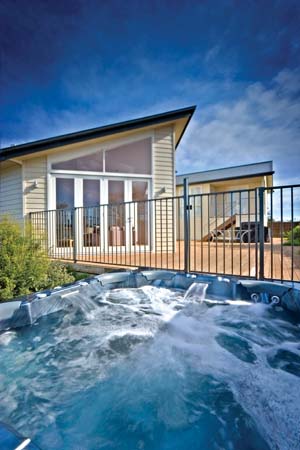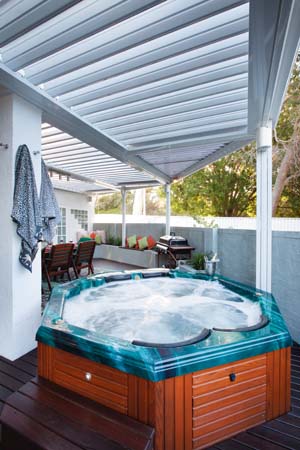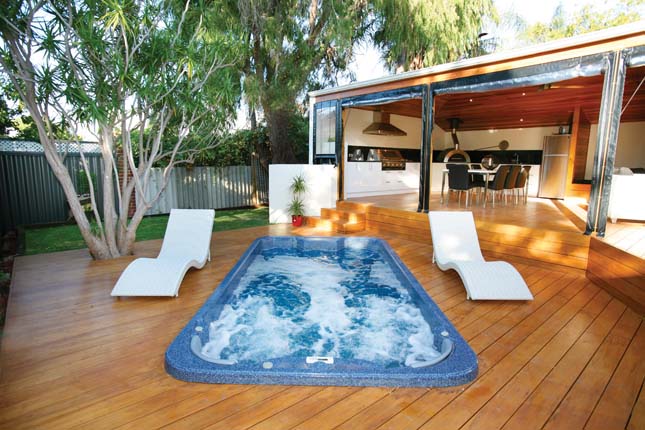Spas and hot tubs not only bring health benefits, they can be a stylish backyard feature.


By Peter Glass
Water is central to all life. The therapeutic and health benefits of water, including the practice of bathing in hot mineral springs, are many and have been recognised for thousands of years.
Although the growing popularity of spas over the past 50 years may lead one to think they are a development of the 20th century, the earliest spas — or “baths” — date back several thousand years to various civilisations, including Mesopotamia, Egypt, Greece and the Roman Empire, where social bathing was an important cultural process providing physical and spiritual purification as well as relief from pain and disease.
The word “spa” is derived from the name of a Belgian spa town, with its origins dating back to the Roman Empire. There are several theories suggesting how the word came into being, including from the Latin word espa, meaning fountain, or the word spagere, meaning to bubble up, scatter, sprinkle or moisten. Other possible origins include salus per aquam or salute per aqua, both Latin for health by/through water; or solus per aqua, meaning to enter through water.
Today, spas satisfy many of the same needs as they did thousands of years ago, including relaxation, the promotion of wellbeing and stress relief through the incorporation of massage therapy and other hydrotherapy treatments.
Warm water massage with the use of jets increases blood flow and circulation in the body, which assists in the elimination of toxins and increasing overall body health, as well as in mitigating the symptoms of muscle strain, arthritis, back pain and chronic pain. Added to this are the general soothing and calming effects of water.
Invention of today’s spa:
The need for accessible hydrotherapy treatment for an ailing family member is what ultimately inspired the invention of a portable whirlpool pump that could turn virtually any vessel of warm water into a spa. Back in 1954, Joe Jacuzzi and his brothers had no way of knowing their invention would spawn a billion-dollar industry. They later refined the pump and coupled it with jets using an air-injection system. The improved blend of bubbles and massaging benefits paved the way for the modern home spa as we know it today. Today, the design of spa jets is based on the Venturi effect, where water is pumped through a funnel-like device to create a vacuum that draws air into the mix.
Parallel to the increasing use of Jacuzzi-style spas was the increasing popularity of hot tubs. These have their origins in Asian cultures and generally consist of free-standing, often round, wooden tubs for hot-water bathing.
They originally involved no jets or air blowers, which were introduced to the concept in the late 1960s. Although hot tubs and spas were both popular until the late ’70s, hot tubs are less common today. These days when a person refers to a hot tub, a spa or even a Jacuzzi, they often generally mean the same thing: a heated body of water with adjustable water jets and bubbles.
Two categories of spas:
Spas have come a long way since the invention of the Jacuzzi and can be primarily differentiated into two types: fibreglass/acrylic or reinforced concrete structures, both offering different advantages. Fibreglass or acrylic spas are mostly (but not necessarily) portable and therefore can often be very quick to install compared to a concrete spa. With the added benefit of lower cost, they also incorporate smooth, contoured seats and lounging areas plus the choice of a wide variety of massage jet options, providing superior hydrotherapy capabilities.
The main advantage of reinforced concrete spas is that design options, especially when attractive and seamless integration into an overall pool or landscape design is required, are limitless. As a result, concrete spas can be designed to create more exciting, aesthetically superior, highly functional and more permanent visual features. If a spa is integrated with a pool, it has the added benefit of the spa water being able to be regularly replaced with water from the pool.
Some things to consider:
In addition, there are general design, safety, sanitation and heating considerations that need to be taken into account when choosing and installing or constructing a spa. These include:
- Location: You need to consider the spa’s proximity to your house, pool and other facilities inside the pool enclosure. The spa needs to be easily accessible.
- Privacy: Keep in mind privacy and protection from sun, rain and wind. You may need to erect some kind of shade or screening.
- Size: A good size for a domestic spa is three to four square metres; this will accommodate use by four to six people.
- User requirements: Is hydrotherapy an important function or is the spa purely for recreational and social activities? What is the likely frequency of use and number of anticipated users?
- Safety: This refers both to fencing requirements to restrict access by children and pets, and safety suction points to prevent the risk of a person drowning from being trapped under the water. It’s important that spas comply with all applicable Australian Standards in that regard. Australia’s standards are recognised as being among the best in the world. In addition, while spas can generally be used year-round, night and day, sun or snow, their use during an electric storm is not recommended.
- Covers: The cover should always be on the spa when it’s not in use. But when it is in use, do you have somewhere to store it?
Sanitation requirements:
There are many options for sanitation systems, depending on whether the spa is part of a total pool-spa system or is to be sanitised separately. Sanitation options include chlorine, bromine, oxidising agents coupled with ionisation, ozonating or chlorine systems, or salt chlorination when part of the pool-spa system.
Chlorine and bromine sanitation have been the traditional sanitation systems for spas for many years and can today be fully automated to ensure regular dosing at lower quantities, resulting in less irritation of eyes and skin. Over the past decade, however, an increasing number of alternative sanitation options that use less and lower concentrations of chemicals have come onto the market. Some of these systems have proven to be very effective and, while at this stage some have higher set-up costs, this is becoming less important compared to improved water quality and reduced ongoing chemical usage.
Heating and filtration:
One of the major benefits of a spa is that it can be used throughout the winter months with relatively minimal costs for heating compared with heating a pool. Heating, however, should be almost “instantaneous” — ready in 15–20 minutes. If you have to wait much longer than that, the moment’s often gone!
Mains gas, where available, is generally the best option, with tank gas generally next best, though a little more costly to run. Neither solar heating (due to obvious problems on cloudy days or in the evening or in winter), electric water heaters (due to their high power requirements and associated high costs), nor electric heat pumps (due to the time delay required to heat the water) are considered practical spa heating options, although they can be used initially to bring the water up to a higher ambient temperature. If a spa was to be used every day, especially during the colder months, the use of a spa blanket should be considered.
When the spa is part of the overall pool system, the spa does not require a separate filtration system; however, an independent spa requires a very efficient filtration system, often with a cartridge filtration system being specified so large quantities of water are not lost during backwashing.
Automation and technology:
The use of computerised electronic control systems can enable the filtration and sanitation of the spa pool to be automated. It can also enable quick and easy activation of any electronic valves between the pool and spa, functioning of the gas heater and spa jets, plus easy checking of the water temperature and pH level. Electronic controllers also provide options for being able to activate the gas heater remotely by telephone to enable the spa water to be pre-heated when you arrive home.
Home spas have become much more sophisticated over the past decade and will continue to do so. They will also continue to gain popularity due to their relaxation and therapeutic benefits. Continued technological advances will result in improved jet design, filtration and sanitation equipment plus more innovative use of materials and accessories, such as lighting and sound, to create unique features. The ubiquitous iPod is already being incorporated into the design of many spas, as is fibre-optic and LED lighting.
While the origins of today’s spas are steeped in history, their future popularity is assured as properties become smaller and space more valuable. When well-designed and constructed, a spa is a wonderful social and recreational facility that can be used by family and friends throughout the year, providing leisure and health benefits as well as being a great water feature and visual asset.
Peter Glass is the managing director and principal landscape architect at Sydney-based Peter Glass and Associates.









